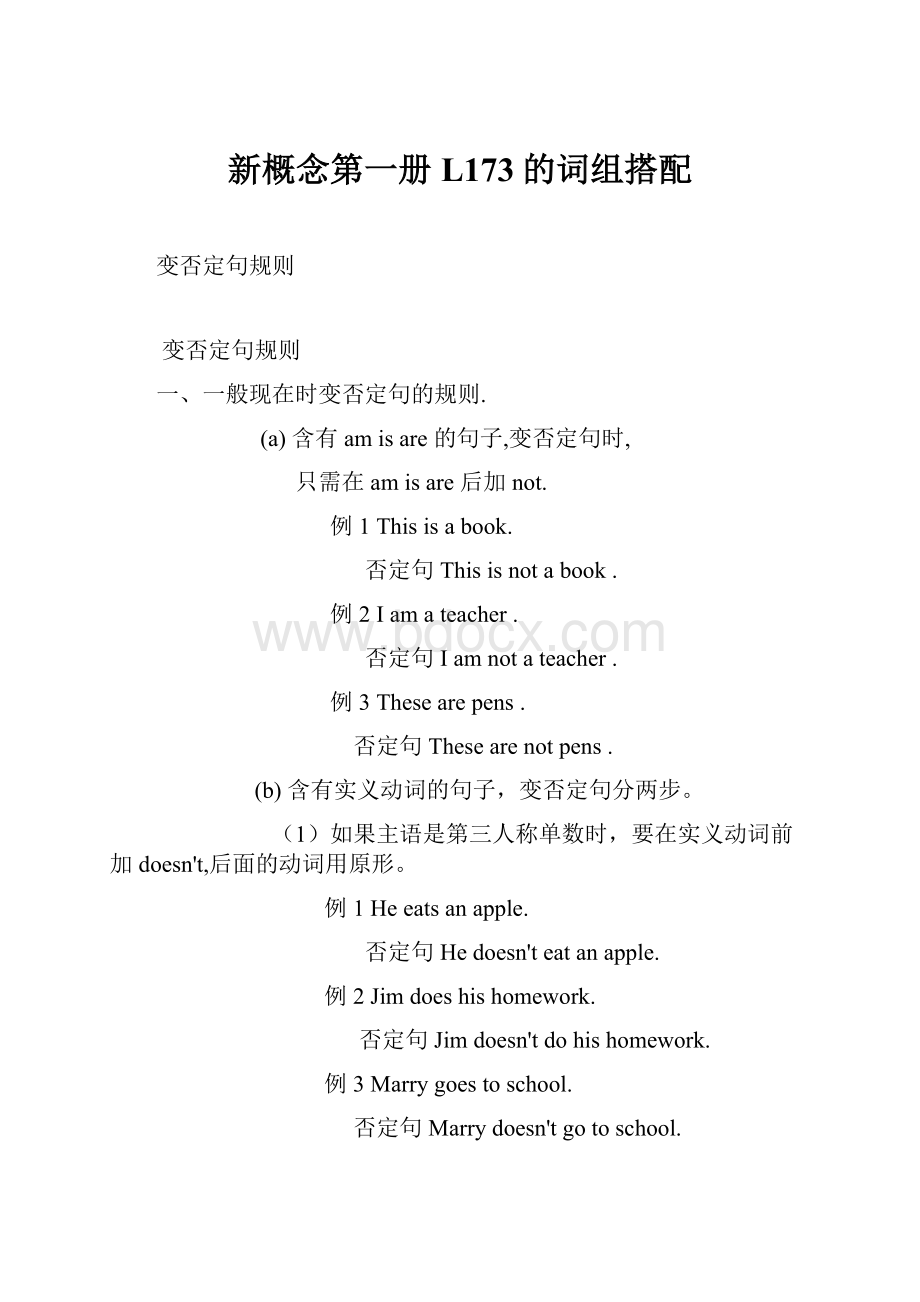新概念第一册L173的词组搭配.docx
《新概念第一册L173的词组搭配.docx》由会员分享,可在线阅读,更多相关《新概念第一册L173的词组搭配.docx(19页珍藏版)》请在冰豆网上搜索。

新概念第一册L173的词组搭配
变否定句规则
变否定句规则
一、一般现在时变否定句的规则.
(a)含有amisare的句子,变否定句时,
只需在amisare后加not.
例1Thisisabook.
否定句Thisisnotabook.
例2Iamateacher.
否定句Iamnotateacher.
例3Thesearepens.
否定句Thesearenotpens.
(b)含有实义动词的句子,变否定句分两步。
(1)如果主语是第三人称单数时,要在实义动词前加doesn't,后面的动词用原形。
例1Heeatsanapple.
否定句Hedoesn'teatanapple.
例2Jimdoeshishomework.
否定句Jimdoesn'tdohishomework.
例3Marrygoestoschool.
否定句Marrydoesn'tgotoschool.
(2)如果主语不是第三人称单数时,只需在实义动词前加don't.
例1IteachEnglish.
否定句Idon'tteachEnglish.
例2Theygotoschool.
否定句Theydon'tgotoschool.
例3Wesingasong.否定句Wedon'tsingasong.
(c)含有情态动词的句子,变否定句时,只需在情态动词后加not.
例1Icandance.
否定句Icannotdance.
或Ican'tdance.
例2TheycanspeakEnglish.
否定句 TheycannotspeakEnglish.
或Theycan'tspeakEnglish.
例3Hemustgohome.
否定句 Hemustnotgohome.
或Hemustn'tgohome.
例4He must be on the playground.
Hecan notbeon the playground.
析:
当must be用来表示推测,有“一定”的含义时,
否定式要用can not.
例5Youmustsaysomethingatthemecting.
Youneedn’tsayanythingatthemecting.
析:
当“must+行为动词”用来表示“必须”的含义时,
其否定式可用needn’t或mustn't表示“不需要”,“不必”,
语气委婉,must not表示“禁止”,“千万别”语气生硬。
例6You may come in now.
You mustn'tcomeinnow.
析:
may作为情态动词表示“可以”时,
其否定式用must not,而不用may not.
例7HemaywatchTV.
Hemustn'twatchTV.
注意:
(1)见到some变否定句时,要换成any.
例1Ieatsomeapples.
否定句Idon'teatanyapples.
例2Hehassomebooks.
否定句Hedoesn'thave anybooks.
例3Hedoeshishomework.
否定句Hedoesn'tdohishomework.
(2)见到and变否定句时,要换成or.
例1Thereissomeairand wateronthemoon.
否定句Thereisn'tanyairorwateronthemoon.
例2Hehassomebrothersandsisters.
否定句Hehasn'tanybrothersorsisters.
例3Heeatsapplesandoranges.
否定句Hedoesn’teatapplesororanges.
(3)见到too和also变否定句时,要换成either.
例1.Tomgoestoschooltoo.
否定句Tomdoesn’tgotoschooleither.
too和also用于肯定句中时,否定句中用either替换。
(4)见到already变否定句时,要换成yet。
例1Hehashadsupperalready.
Hehasn’thadsupperyet.
随着对谓语动词的否定,某些副词也要作相应的变动。
英语句型转换错误分析:
肯定句变否定句
1.Ithinksheisthere.
误:
Ithinksheisn’tthere.
正:
Idon’tthinksheisthere.
析:
英语中think,believe,expect,suppose等表示信念和揣测的动词,
后接that从句时,习惯上将从句中的否定形式转移到主句上,
即否定主句谓语,不否定从句谓语。
2.Hecansingthissongandthatone.
误:
Hecannotsingthissongandthatone.
正;Hecannotsingthissongorthatone.
析:
肯定句中的连词and在否定句中一般要改为or。
3.Tomwenttoschooltoo.
误:
Tomdidn’tgotoschooltoo.
正:
Tomdidn’tgotoschooleither.
析:
too和also用于肯定句中时,否定句中用either替换。
4.Hehashadsupperalready.
误:
Hehasn’thadsupperalready.
正:
Hehasn’thadsupperyet.
析:
随着对谓语动词的否定,某些副词也要作相应的变动。
5.Hehadagoodrestjustnow.
误:
Hehadn’tagoodrestjustnow.
正:
Hedidn’thaveagoodrestjustnow.
析:
have在表示开会、吃饭、休息、进行体育锻炼等词组中是行为动词,
否定句用助动词来完成。
6.Let’sdoit.
误:
Let’sdon’tdoit.
正:
Don’tlet’sdoit.或Let’snotdoit.
析:
let后接的是不带to的不定式,变为否定式,
直接在句首前加Don’t或在不定式前加not。
7.Healwaysgetsthereontime.
误:
Hedoesn’talwaysgetthereontime.
正:
Henevergetsthereontime.
析:
Hedoesn’talwaysgetthereontime意为
“他并非老是准时到那儿”,是部分否定,
习惯上把句中的副词改为相应的表示否定的副词即可。
如:
Itoftenrainshere.Itseldomrainshere.
8.Behereearlytomorrow.
误:
Benothereearlytomorrow.
正:
Don’tbehereearlytomorrow.
析:
祈使句的否定,一般在谓语动词前加donot的缩写don’t。
9.Youhadbettercome.
误:
Youdidn’thavebettercome.
正:
Youhadbetternotcome.
析:
hadbetter相当于一情态动词,不可分割,
因此not应放在其后。
wouldrather也是如此。
10.BothTomandXiaoPingwenttoschool.
误:
BothTomandXiaoPingdidn’tgotoschool.
正:
NeitherTomnorXiaoPingwenttoschool.
析:
一个句子中如果有不定代词both,all,every改为否定式时,
要把这些不定代词改为相应的表示否定的代词。
二一般过去时变否定句规则
(a)含有waswere 的句子,变否定句时,只需在waswere后加not.
例1 This wasabook.
否定句This wasnotabook.或This wasn'tabook.
例2 Iwasateacher.
否定句Iwasnotateacher.或Iwasn'tateacher.
例3 Thesewerepens.
否定句Thesewerenotpens.或Theseweren'tpens
(b)含有实义动词过去式的句子,变否定句时,
只需在实义动词过去式前加didn't,后面的动词用原形。
例1Heateanapple.
否定句Hedidn'teatanapple.
例2Jimdidhishomework.
否定句Jimdidn'tdohishomework.
例3Marrywenttoschool.
否定句Marrydidn'tgotoschool.
(c)含有情态动词过去式的句子,变否定句时,只需在情态动词过去式后加not.
(cancould,maymight,needneed,mustmust)
例1Icoulddance.
否定句Icouldnotdance.
或Icouldn’tdance.
例2TheycouldspeakEnglish.
否定句 TheycouldnotspeakEnglish.
或Theycouldn’tspeakEnglish.
例3He could swim,so can I.
Hecouldswim,neither(nor)canI
析:
在“陈述句+so+助(系情态)动词+主语”结构中,
若改为否定句,除陈述部分加副词not外,还需将so改为neither或nor。
例4Hemustgohome.
否定句Hemustnotgohome.
或Hemustn'tgohome.
例5He must be on the playground.
Hecouldnotbeon the playground.
析:
当must be用来表示推测,有“一定”的含义时,否定式要用can not.
例6Youmustsaysomethingatthemecting.
Youneedn’tsayanythingatthemecting.
析:
当“must+行为动词”用来表示“必须”的含义时,
其否定式可用needn’t或mustn't表示“不需要”,“不必”,
语气委婉,must not表示“禁止”,“千万别”语气生硬。
例7You might come in now.
You mustn'tcomeinnow.
析:
may作为情态动词表示“可以”时,
其否定式用must not,而不用may not.
例8HemightwatchTV.
Hemustn'twatchTV.
注意:
(1)见到some变否定句时,要换成any.
(2)见到and变否定句时,要换成or.
(3)见到too和also变否定句时,要换成either.
例1.Tomgoestoschooltoo.
否定句Tomdoesn’tgotoschooleither.
too和also用于肯定句中时,否定句中用either替换。
(4)见到already变否定句时,要换成yet。
例1Hehashadsupperalready.
Hehasn’thadsupperyet.
三.现在进行时变否定句规则
1规则:
现在进行时变否定句时,只需在be[amisare]后加not.
例1IamwatchingTV.
否定句 IamnotwatchingTV.
或I’mnotwatchingTV
例2Theyareplayingbasketball.
否定句Theyarenotplayingbasketball
或Theyaren'tplayingbasketball.
2注意:
(1)见到some变否定句时,要换成any.
例1Iameatingsomeapples.
否定句Iamnoteatinganyapples.
或I’mnoteatinganyapples.
例2Theyaresingsingsomesongs.
否定句Theyarenotsingsinganysongs.
或Theyaren'tsingsinganysongs.
(2)见到and变否定句时,要换成or.
例1Iameatingapplesandoranges.
否定句Iamnoteatingapplesororanges.
或I’mnoteatingorapples.
(3)见到too和also变否定句时,要换成either.
例1.Tomgoestoschooltoo.
否定句Tomdoesn’tgotoschooleither.
too和also用于肯定句中时,否定句中用either替换。
(4)见到already变否定句时,要换成yet。
例1Hehashadsupperalready.
Hehasn’thadsupperyet.
四.过去进行时变否定句规则
过去进行时变否定句时,只需在be[waswere]后加not.
例1IwaswatchingTV.
否定句IwasnotwatchingTV.
例2Theywereplayingbasketball.
否定句Theywerenotplayingbasketball
或Theyweren'tplayingbasketball.
注意:
(1)见到some变否定句时,要换成any.
例1Iwaseatingsomeapples.
否定句Iwasnoteatinganyapples.
例2Theyweresingsingsomesongs.
否定句Theywerenotsingsinganysongs.
或Theyweren'tsingsinganysongs.
(2)见到and变否定句时,要换成or.
例1Iwaseatingapplesandoranges.
否定句Iwasnoteatingapplesororanges.
或Iwasn’teatingapplesororanges.
例2HewasspeakingEnglishandFrench.
] 否定句HewasnotspeakingEnglishorFrench.
或Hewasn’tspeakingEnglishorFrench.
(3)见到too和also变否定句时,要换成either.
例1.Tomgoestoschooltoo.
否定句Tomdoesn’tgot